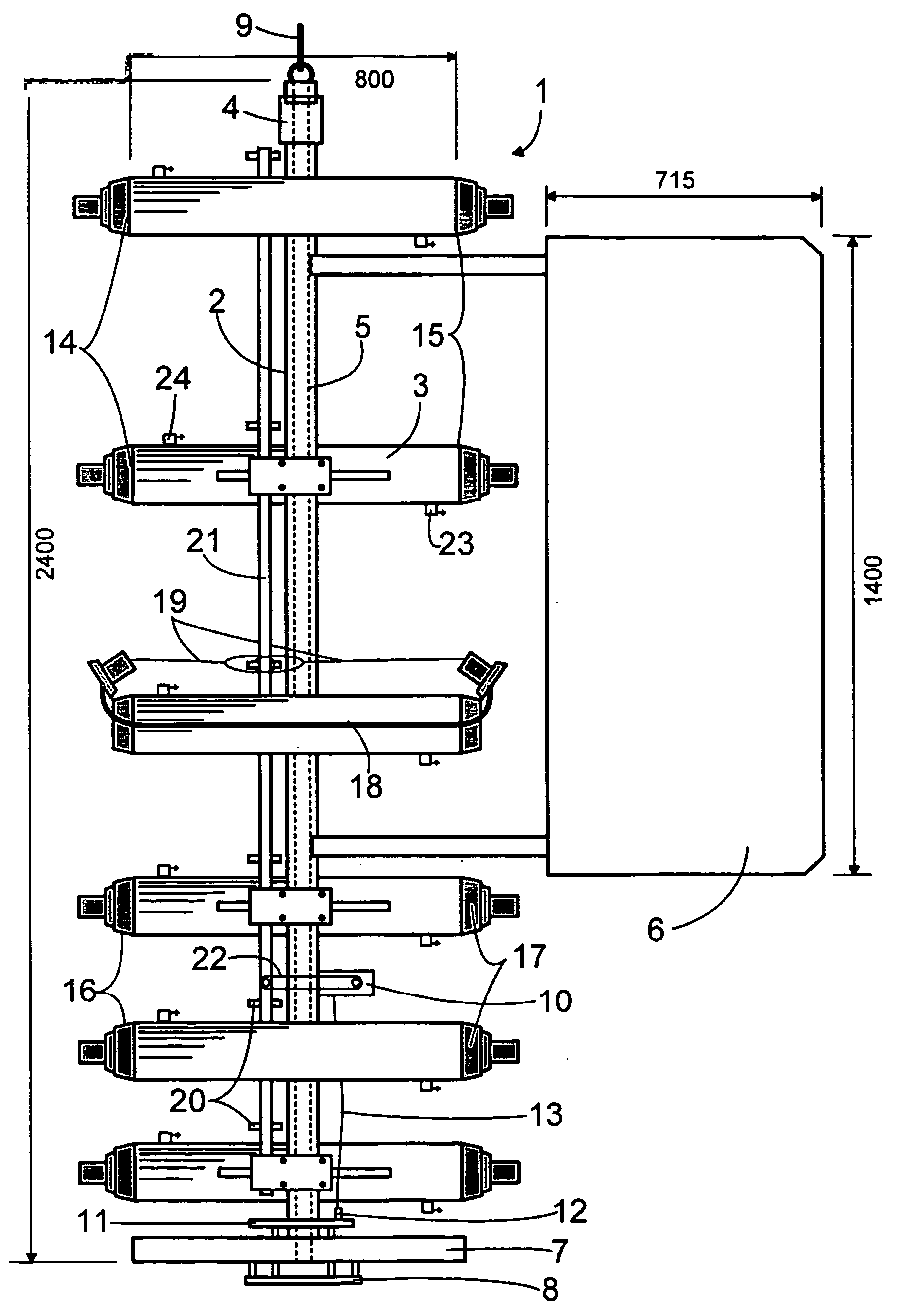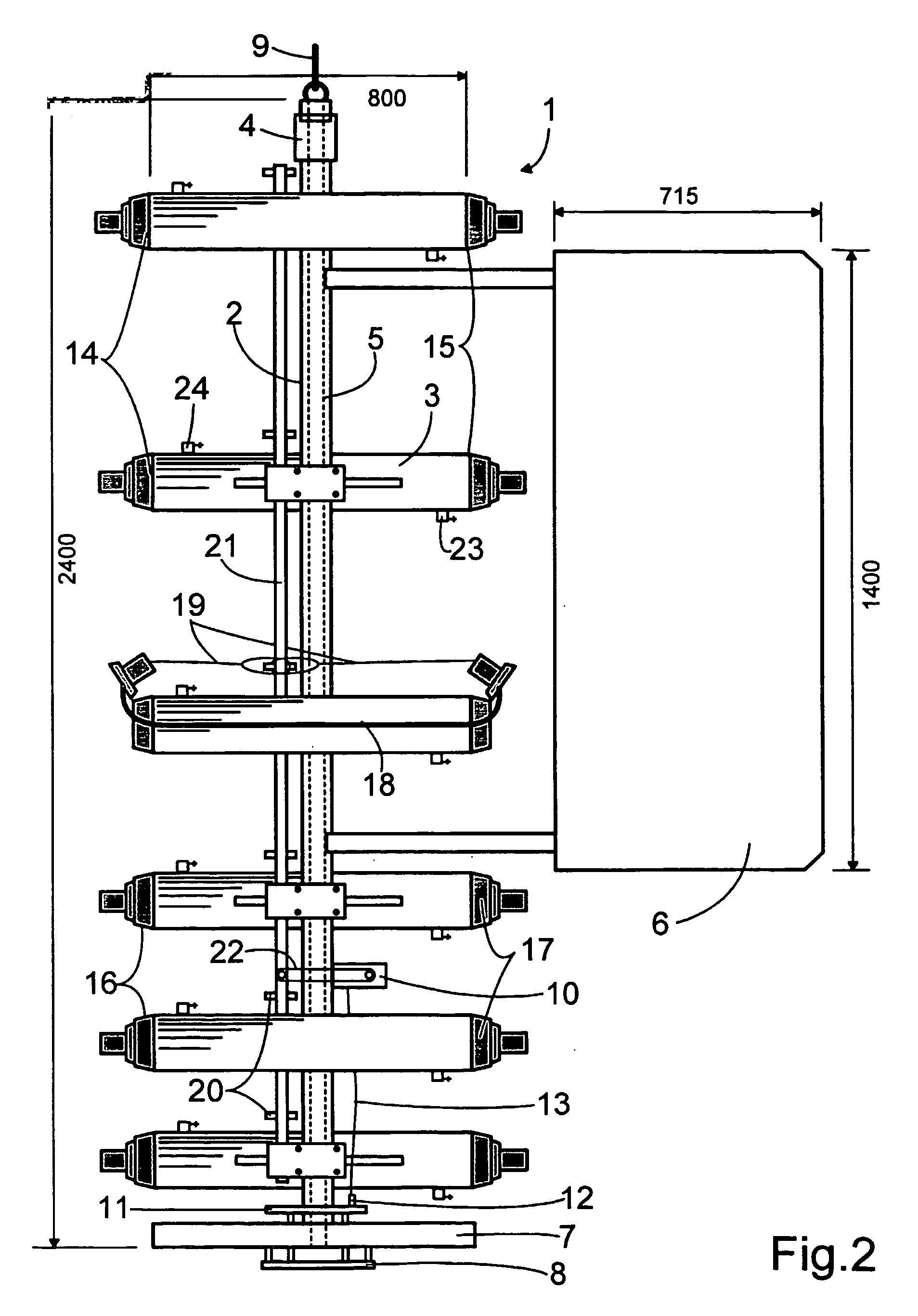[0009] Proceeding from the closest state of the art discussed supra, the object of the present invention is to be seen in improving a bed water sampling device of the kind under consideration for the simultaneous collection of several undisturbed samples of water from different levels of the lowest
water column above the water bed by several horizontally oriented cylindrical sample containers so that undisturbed and high-resolution samples may be taken from the current adjacent to the bed in the material and particle containing transition zone between the water bed and the column of water while substantially maintaining the original state of the water to be sampled. The improved bed water sampling device is to make possible taking of samples as quickly as possible, and in terms of handling it is to be simple and robust. Moreover, particles stirred up when placing the sampling device on the water bed as well as water from other
layers in the water column are to be flushed out of the containers by the original bed water prior to their closure. SUMMARY OF THE INVENTION
[0011] The bed water sampling device in accordance with the invention combines high functionality to accommodate high-value water sampling demands. To be mentioned among these is the taking of samples from different water horizons free of any admixture and without suction and with a particular degree of field suitability, especially in view of the fact that the submersion cable may be freely selected, that the dwell time on the bed is short and the
resultant minimum requirements in terms of the position of the ship. In this respect, the relationship between the concept of the release for the simultaneous closure of all of the sample containers at both ends and their simple and automatic alignment with the bed is essential. Since both ends of the sample containers are open before the samples are collected, genuine bed water may freely flow through them. Thus, at the instance both ends of the sample containers are closed, a sample of water is trapped in its
free state of flow and, therefore, substantially original state. Since the water samples are collected without suction, any error-generating loss of gas in the
water sample otherwise caused by the lowered
solubility of gases in water as a result of suction-generated negative pressure is avoided. Alignment in the current is brought about by a sufficiently large flow vane rigidly connected to the freely rotatable support rod. The size of the vane is dimensioned such that even weak currents in the bed water zone close to the bottom will suffice to rotate and align the sample container on the central support rod in the current.
[0012] Furthermore, the time-
controlled release ensures the taking of samples in undisturbed current conditions. The sample containers are closed only after any disturbances caused by placing the measuring arrangement on the water bed have subsided. Automatic actuation of the release takes place mechanically by upward pressure acting on a release plate disposed beneath the heavy base frame for a sufficiently long period, for instance one minute. In this manner, premature closure of the sample containers resulting, for instance, when accidentally placing the sampling device aboard ship during a placement operation, is substantially avoided. Moreover, because of the entirely mechanical actuation there is no need for a sensitive line for feeding control pulses from the surface of the water. The closure devices of the sample containers are actuated by an integrated
time control—this may, for instance, be an electronic
timer which, depending on its pressure
capsule, can be applied at depths of 6,000 m and beyond, for instance—upon its actuation after a select time
delay, e.g. a few minutes after placement of the sampling device. Hence, two integrated time loops are provided for a secure and flawless operation of the bed water sampling device in accordance with the invention.
[0013] In order to disturb the bed as little as possible the structure of the bed water sampling device advantageously has no exterior braces or tension wire devices. Flow dynamic mixing of
layers of bed water by artificial turbulence is avoided. The stable vertical position of the apparatus on the water bed is achieved, for instance, by a base frame weighted by lead
ballast units. The bed water sampling device in accordance with the invention is suitable for
deep sea operation and may, depending upon the stability of the pressure
capsule of the release, be used in depths of water of 6,000 m and more. Overall, a bed dwell time of 5 minutes up to a maximum of 10 minutes is needed for taking samples. During a time interval of so short a duration it is possible without any difficulty sufficiently precisely to maintain the position of the ship relative to the sampling device so that entanglements of, or kinks in, the sinking steel cable occurring in consequence of veering made necessary by the ship moving because of wind or surface currents, may with a great
degree of certainty be avoided.
[0015] For purposes of a non-invasive taking of samples it is important that transfer of the water samples for subsequent examination onboard the ship take place with little mixing with air in order to prevent an unintentional absorption or
discharge of gases from or into the
atmosphere. In accordance with a further advantageous embodiment of the invention, every sample container may for this purpose be provided with a
water discharge valve and, diametrically opposite, an air intake valve. In this manner, the air replacing the water flowing out of the container may uniformly flow into the container without any mixing of water and air. Any exchange of gas with the
atmosphere is thus limited to a minimum. In accordance with a further embodiment of the invention the sample container are transparent. In this manner it is possible to obtain an indication of the particle content and particle structure in individual water samples during the taking of the samples have been taken, by a camera, for instance, or by photographing or
visual inspection before the sample is discharged
on board ship.
[0018] Since the bed water sampling device in accordance with the invention does not use braces and tension wires which would interfere with the bed current, the stable vertical position of the apparatus is ensured by the base frame being weighted by
ballast units made of lead, for instance. Furthermore, in another embodiment of the invention several
buoyancy units may be attached to a steel cable above the sampling device. For instance, two
buoyancy units may be mounted about 15 m above the sampling device, and in concert with the
ballast units effectively prevent the bed water sampling device in accordance with the invention from overturning.
 Login to View More
Login to View More  Login to View More
Login to View More 


